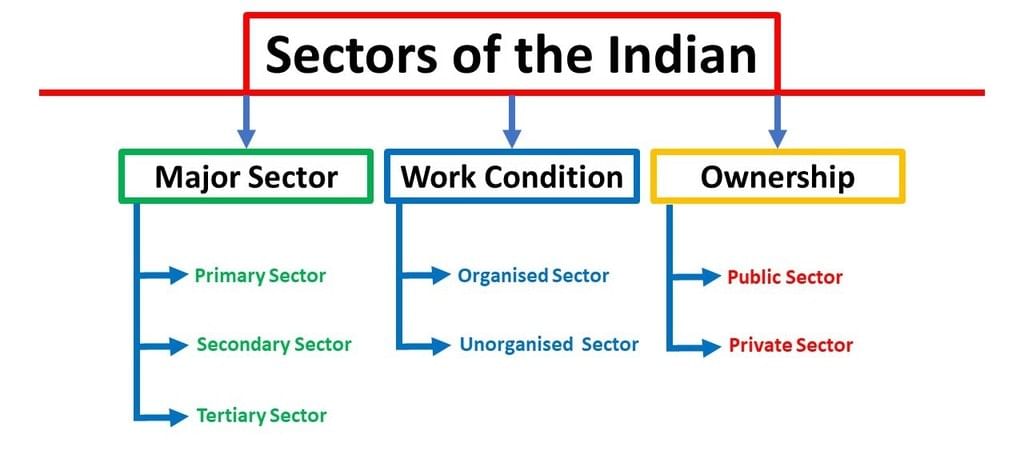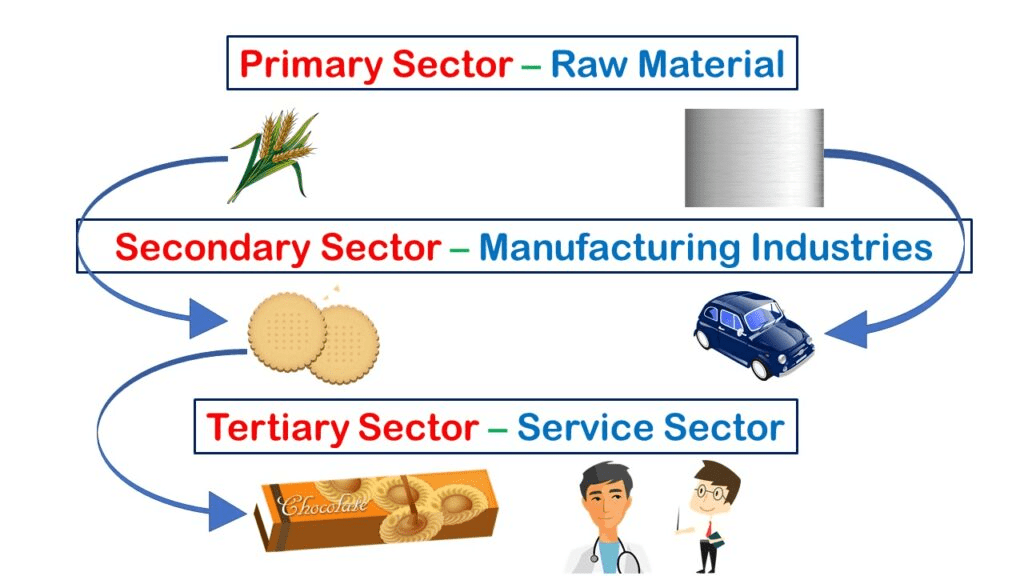Sectors of the Economy | Geography for UPSC CSE PDF Download
| Table of contents |

|
| Economic Activities |

|
| Classification of Indian Economic Sector |

|
| 1. On the Basis of Activity Nature |

|
| 2. On the Basis of Work Condition |

|
| Organized Sector |

|
| 3. On the Basis of Ownership |

|
Economic Activities
An economic activity is a process that, based on inputs, leads to the manufacture of a good or the provision of a service.
- Human activities that generate income are known as economic activities.
- Production, consumption, and capital formation are called the basic economic activities of an economy.
 Sectors of Indian Economy
Sectors of Indian Economy
- Economic activities are broadly grouped into primary, secondary, tertiary, quaternary, and quinary activities on the basis of Activity Nature.
- On the basis of work conditions, India's Economic Sector is divided into an Organised and Unorganised Sector.
- On the basis of asset ownership, it is divided into the Public and Private Sectors.
Classification of Indian Economic Sector
1. On the Basis of Activity Nature
The economic sector is classified on the basis of the nature of activities in three sectors, namely, Primary, Secondary, and Tertiary sectors. Higher services under tertiary activities are again classified into quaternary and quinary activities.
Primary Activities
Primary activity includes those occupations which are closely related to man's natural environment.
- Primary activities are directly dependent on the environment as these refer to the utilization of the earth’s resources such as land, water, vegetation, building materials, and minerals.
- It, thus includes hunting and gathering, pastoral activities, fishing, forestry, agriculture, and mining and quarrying.
- People engaged in primary activities are called red-collar workers due to the outdoor nature of their work.

Secondary Activities
Secondary activities are those activities which involve the manufacturing of finished goods by processing the raw materials that are found in the nature.
- Secondary activities add value to natural resources by transforming raw materials into valuable products.
- Secondary activities, therefore, are concerned with manufacturing, processing, and construction (infrastructure) industries.
- People engaged in secondary activities are called blue-collar workers.
Tertiary Activities
Tertiary activity consists of all service occupations. Transport, communication, trade, health, education and administration are important examples of tertiary activities.
- Tertiary activities include both production and exchange.
- The production involves the ‘provision’ of services that are ‘consumed.
- The exchange involves trade, transport, and communication facilities that are used to overcome distance.
- Tertiary jobs = White-Collar jobs.
Quaternary Activities
Quaternary activities are specialized tertiary activities in the ‘Knowledge Sector’ which demands a separate classification.
- There has been a very high growth in demand for and consumption of information-based services from mutual fund managers to tax consultants, software developers, and statisticians.
- Personnel working in office buildings, elementary schools and university classrooms, hospitals and doctors’ offices, theatres, accounting, and brokerage firms all belong to this category of services.
- Like some of the tertiary functions, quaternary activities can also be outsourced. They are not tied to resources, affected by the environment, or necessarily localized by the market.
Quinary Activities
Quinary activities are services that focus on the creation, re-arrangement and interpretation of new and existing ideas; data interpretation and the use and evaluation of new technologies.
- Often referred to as ‘gold collar’ professions, they represent another subdivision of the tertiary sector representing special and highly paid skills of senior business executives, government officials, research scientists, financial and legal consultants, etc.
- Their importance in the structure of advanced economies far outweighs their numbers.
- The highest level of decision-makers or policymakers performs quinary activities.
- Quinary = Gold collar professions.
2. On the Basis of Work Condition
Organized Sector
Organized Sector is a sector where the employment terms are fixed and regular, and the employees get assured work.
- They are registered by the government and have to follow its rules and regulations, which are given in various laws such as the Factories Act, Minimum Wages Act, Payment of Gratuity Act, Shops and Establishments Act, etc.
- The job is regular and has fixed working hours. If people work more, they get paid for the overtime by the employer.
Workers enjoy the security of employment.
People working in the organized sector get several other benefits from the employers such as paid leave, payment during holidays, provident funds, gratuity, etc.
People get medical benefits. The factory manager has to ensure facilities like drinking water and a safe working environment.
When they retire, these workers get pensions as well.
Examples of the organized sectors are Government employees, registered industrial workers, Anganwadi workers, village health workers, etc.
Unorganized Sector
The unorganised sector is characterised by small and scattered units, which are largely outside the control of the government.
 Daily Wage Labourers are included in Unorganized Sector
Daily Wage Labourers are included in Unorganized Sector
- There are rules and regulations but these are not followed since they are not registered with the government.
- Jobs are low-paid and often not regular.
- Employment is not secure. People can be asked to leave without any reason.
- There is no provision for overtime, paid leave, holidays, leave due to sickness, etc.
- There are no such facilities in the unorganized sector.
- Examples of the unorganized sectors are Shopkeeping, Farming, Domestic works, Labouring, Rickshaw pulling, etc.
3. On the Basis of Ownership
Public Sector
- In the public sector, the government owns most of the assets and provides all the services.
- Railways or post office is an example of the public sector.
- The purpose of the public sector is not just to earn profits. Its main aim is public welfare.
Private Sector
- In the private sector, ownership of assets and delivery of services is in the hands of private individuals or companies.
- Companies like Tata Iron and Steel Company Limited (TISCO) or Reliance Industries Limited (RIL) are privately owned companies.
- Activities in the private sector are guided by the motive to earn profits.
|
175 videos|619 docs|192 tests
|
FAQs on Sectors of the Economy - Geography for UPSC CSE
| 1. What is the classification of Indian economic sectors based on activity nature? |  |
| 2. How can Indian economic sectors be classified based on work condition? |  |
| 3. What is the organized sector in the Indian economy? |  |
| 4. How are sectors of the Indian economy classified based on ownership? |  |
| 5. What are some examples of economic activities in the primary sector of the Indian economy? |  |





















